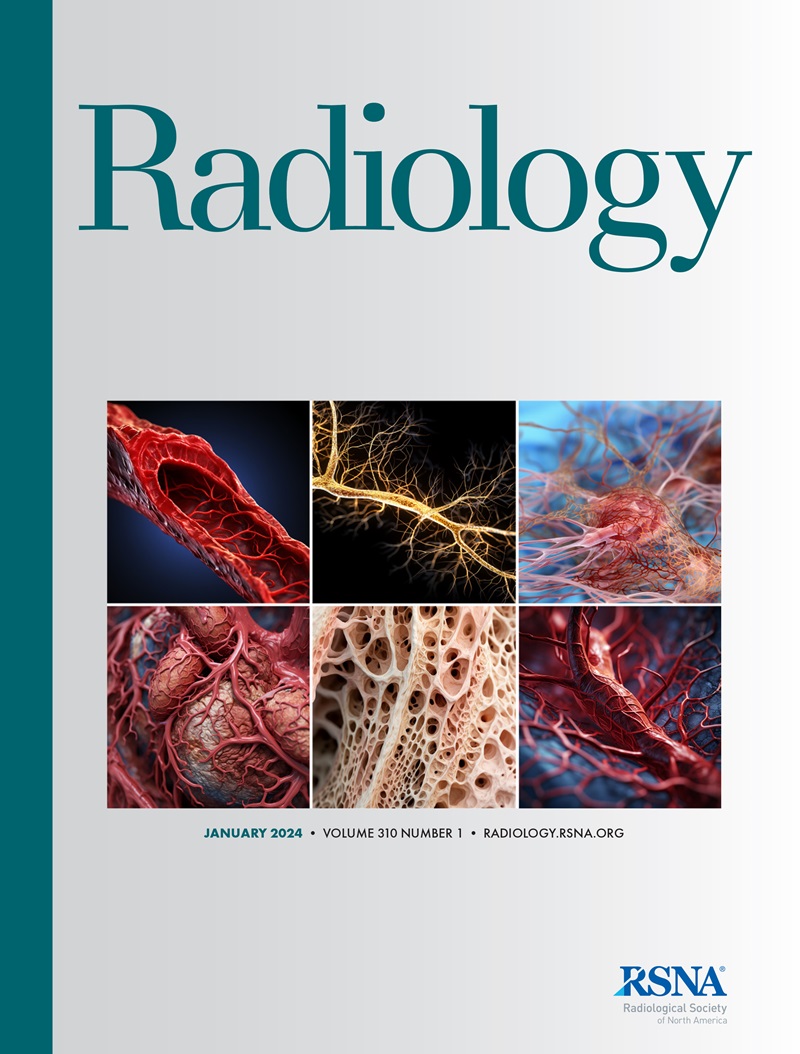Nooshin Abbasi, Neena Kapoor, Ronilda Lacson, Jeffrey P Guenette, Sonali Desai, David Lucier, Sanjay Saini, Rachel Sisodia, Ali S Raja, David W Bates, Ramin Khorasani
求助PDF
{"title":"靶向干预对放射科医生推荐额外成像的累积效应。","authors":"Nooshin Abbasi, Neena Kapoor, Ronilda Lacson, Jeffrey P Guenette, Sonali Desai, David Lucier, Sanjay Saini, Rachel Sisodia, Ali S Raja, David W Bates, Ramin Khorasani","doi":"10.1148/radiol.243750","DOIUrl":null,"url":null,"abstract":"<p><p>Background Ambiguous or unnecessary radiologist recommendations for additional imaging (RAIs) can lead to excessive imaging use and diagnostic errors. Purpose To determine the cumulative impacts of multifaceted technology-enabled interventions aimed at optimizing RAI on RAI rate, actionability, and resolution over an 8-year period. Materials and Methods In this retrospective cohort study, conducted from January 2015 to December 2022, radiology reports from two tertiary hospitals (study site and control site) were analyzed. A series of quality improvement interventions, including radiologist education, electronic communication tools for tracking RAIs, and performance reports, were implemented at the study site but not at the control site. The RAI rate trend over time was compared between the sites using linear regression. Mixed-effects logistic regression was performed to assess the intervention impact on the RAI rate. RAI actionability and resolution were compared between the sites using the Fisher exact test. <i>P</i> values were corrected using the Bonferroni method. Results Among 7 502 521 total radiology reports (1 323 459 patients) (study site, 3 608 977 reports and 660 051 patients; control site, 3 893 544 reports and 690 115 patients), the RAI rate of the study site decreased by 44%, from 10% (8202 of 81 586) to 5.6% (8972 of 159 599), but remained unchanged at the control site, at 10.9% (8757 of 80 030) vs 11% (16 978 of 153 711) (regression coefficient, -0.09; 95% CI: -0.1, -0.09; <i>P</i> < .001). RAI rates declined with each successive intervention at the study site (<i>P</i> < .001), with regression coefficients decreasing progressively from -0.12 (95% CI: -0.14, -0.10) for the initial intervention to -0.81 (95% CI: -0.83, -0.78) for the final intervention. Recommendation actionability at the study site increased 7.6-fold (from 5.6% [19 of 340] to 42.3% [144 of 340]; <i>P</i> < .001) but remained unchanged at the control site (from 15.0% [51 of 340] to 13.8% [47 of 340]; <i>P</i> = .73). Actionable RAIs were more frequently resolved at the study site than at the control site (84.7% [122 of 144] vs 59.6% [28 of 47]; <i>P</i> < .001). Conclusion Multifaceted interventions to optimize RAI improved the rate, actionability, and resolution of RAI. © RSNA, 2025 <i>Supplemental material is available for this article.</i> See also the editorial by Russell in this issue.</p>","PeriodicalId":20896,"journal":{"name":"Radiology","volume":"315 3","pages":"e243750"},"PeriodicalIF":15.2000,"publicationDate":"2025-06-01","publicationTypes":"Journal Article","fieldsOfStudy":null,"isOpenAccess":false,"openAccessPdf":"","citationCount":"0","resultStr":"{\"title\":\"Cumulative Effect of Targeted Interventions on Radiologist Recommendations for Additional Imaging.\",\"authors\":\"Nooshin Abbasi, Neena Kapoor, Ronilda Lacson, Jeffrey P Guenette, Sonali Desai, David Lucier, Sanjay Saini, Rachel Sisodia, Ali S Raja, David W Bates, Ramin Khorasani\",\"doi\":\"10.1148/radiol.243750\",\"DOIUrl\":null,\"url\":null,\"abstract\":\"<p><p>Background Ambiguous or unnecessary radiologist recommendations for additional imaging (RAIs) can lead to excessive imaging use and diagnostic errors. Purpose To determine the cumulative impacts of multifaceted technology-enabled interventions aimed at optimizing RAI on RAI rate, actionability, and resolution over an 8-year period. Materials and Methods In this retrospective cohort study, conducted from January 2015 to December 2022, radiology reports from two tertiary hospitals (study site and control site) were analyzed. A series of quality improvement interventions, including radiologist education, electronic communication tools for tracking RAIs, and performance reports, were implemented at the study site but not at the control site. The RAI rate trend over time was compared between the sites using linear regression. Mixed-effects logistic regression was performed to assess the intervention impact on the RAI rate. RAI actionability and resolution were compared between the sites using the Fisher exact test. <i>P</i> values were corrected using the Bonferroni method. Results Among 7 502 521 total radiology reports (1 323 459 patients) (study site, 3 608 977 reports and 660 051 patients; control site, 3 893 544 reports and 690 115 patients), the RAI rate of the study site decreased by 44%, from 10% (8202 of 81 586) to 5.6% (8972 of 159 599), but remained unchanged at the control site, at 10.9% (8757 of 80 030) vs 11% (16 978 of 153 711) (regression coefficient, -0.09; 95% CI: -0.1, -0.09; <i>P</i> < .001). RAI rates declined with each successive intervention at the study site (<i>P</i> < .001), with regression coefficients decreasing progressively from -0.12 (95% CI: -0.14, -0.10) for the initial intervention to -0.81 (95% CI: -0.83, -0.78) for the final intervention. Recommendation actionability at the study site increased 7.6-fold (from 5.6% [19 of 340] to 42.3% [144 of 340]; <i>P</i> < .001) but remained unchanged at the control site (from 15.0% [51 of 340] to 13.8% [47 of 340]; <i>P</i> = .73). Actionable RAIs were more frequently resolved at the study site than at the control site (84.7% [122 of 144] vs 59.6% [28 of 47]; <i>P</i> < .001). Conclusion Multifaceted interventions to optimize RAI improved the rate, actionability, and resolution of RAI. © RSNA, 2025 <i>Supplemental material is available for this article.</i> See also the editorial by Russell in this issue.</p>\",\"PeriodicalId\":20896,\"journal\":{\"name\":\"Radiology\",\"volume\":\"315 3\",\"pages\":\"e243750\"},\"PeriodicalIF\":15.2000,\"publicationDate\":\"2025-06-01\",\"publicationTypes\":\"Journal Article\",\"fieldsOfStudy\":null,\"isOpenAccess\":false,\"openAccessPdf\":\"\",\"citationCount\":\"0\",\"resultStr\":null,\"platform\":\"Semanticscholar\",\"paperid\":null,\"PeriodicalName\":\"Radiology\",\"FirstCategoryId\":\"3\",\"ListUrlMain\":\"https://doi.org/10.1148/radiol.243750\",\"RegionNum\":1,\"RegionCategory\":\"医学\",\"ArticlePicture\":[],\"TitleCN\":null,\"AbstractTextCN\":null,\"PMCID\":null,\"EPubDate\":\"\",\"PubModel\":\"\",\"JCR\":\"Q1\",\"JCRName\":\"RADIOLOGY, NUCLEAR MEDICINE & MEDICAL IMAGING\",\"Score\":null,\"Total\":0}","platform":"Semanticscholar","paperid":null,"PeriodicalName":"Radiology","FirstCategoryId":"3","ListUrlMain":"https://doi.org/10.1148/radiol.243750","RegionNum":1,"RegionCategory":"医学","ArticlePicture":[],"TitleCN":null,"AbstractTextCN":null,"PMCID":null,"EPubDate":"","PubModel":"","JCR":"Q1","JCRName":"RADIOLOGY, NUCLEAR MEDICINE & MEDICAL IMAGING","Score":null,"Total":0}
引用次数: 0
引用
批量引用

 求助内容:
求助内容: 应助结果提醒方式:
应助结果提醒方式:


